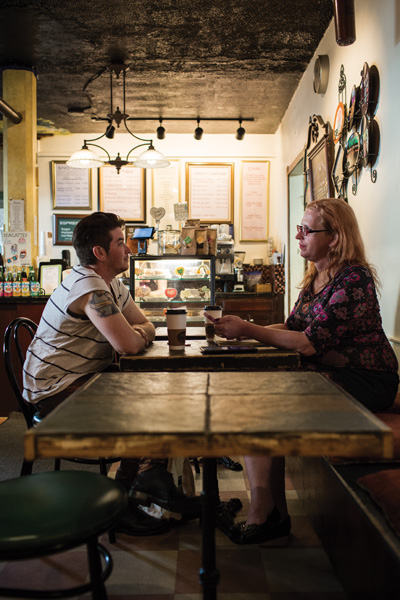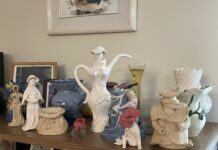“The truth of the matter is, a lot of us are living very mundane, familiar lives,” Rahne Alexander says, her hands wrapped around an Americano at Station North’s BAMF Cafe. “My life is just my life, but I see every moment of it as a potential for activism. I call it the ‘Quotidian Queer’—day-to-day interaction that can make significant change.”
This idea of effecting change through mundanity is the impetus behind “Inside/Out,” Alexander’s upcoming exhibit at the Baltimore Museum of Art with fellow transgender artist Jaimes Mayhew. (Both were featured in STYLE’s “Say My Name,” found in last year’s Arts issue.) The exhibit, linked to the Patricia and Mark Joseph Education Center’s “Imagining Home,” is the second installment of the BMA’s Commons Collaboration project.
Opening Sept. 18, Alexander and Mayhew’s exhibition takes the umbrella concept of home quite literally: “Inside/Out” will depict a large-scale bedroom, belonging to a rotating cast of representative LGBTQ community members.
“The bedroom is such a contentious space,” Mayhew says. “Thinking about the queer domestic arena, that’s what all the laws are made about—what happens in the bedroom.”
Not only that, Alexander adds, but the sheer appearance of that room can have surprising implications: “For those of us from a certain generation, coming out often meant making sure that when you had relatives visit, you would ‘de-gay’ the house—you’d have to jump out of yourself and look around your space, thinking ‘That book is too queer, that tchotchke is too revealing, hide these photos’… That sort of thing. One of the things we really want to explore with ‘Inside/Out’ is what these rooms look like when we haven’t sanitized them for that type of consumption.”
Central to both the concept and the physical exhibit is, of course, a bed—a larger-than-life take on the salon staple that will also serve as seating for viewing the exhibit’s other components.
To the artists, even this, the most unremarkable act of sitting, is part of the display’s power.
“We’re going to try to make it really inviting, but no matter who you are, you’re sitting on a queer bed,” says Mayhew. The effect is profound; immediately, a visitor to the exhibit has implicated themselves in a life that may have previously felt foreign or, in some cases, been perceived as morally wrong.
“We really want to make sure that people feel both comfortable and uncomfortable in the space,” adds Alexander, noting that these emotions apply to herself and Mayhew as well. “It’s not really our space, either, so it will be really interesting for us to claim ownership of it and also not—which I think is a very queer aesthetic.”
After all, as the artists pointed out, much of the queer community has a complicated relationship with the spaces they occupy. According to Mayhew, many have chosen or been forced to leave their homes due to homo- or transphobia—and, even within accepting communities, lines are often drawn by class, gender and race.
“It’s an artistic pun that we’re functioning with,” says Alexander, explaining a quilt in the exhibition that will feature a gridded ‘pattern’ of submitted home movies. “We’re often stitched together in this community. It’s become seamless in the public discourse: ‘LGBTQ,’ that’s something people say all the time now, as if we’re one unified community, not fractured and divided. It’s going to take a lot of work to get past that … but here we are, literally stitching this thing together all on the same communal cloth.”
In addition to the home movies representing Baltimore’s quilt-like queer population, Alexander and Mayhew will be cycling through a number of “identity shifts” in “Inside/Out.” The material in the exhibit will be switched out every two months to encapsulate a new imaginary occupant of the room, from “a black lesbian couple married for 20 years to a swinging bachelor butch.” Alexander and Mayhew hope that this will allow for an even broader understanding of both the everyday lives and challenges of the diverse LGBTQ community.
Their work will more directly extend into that community as well. As part of the Commons Collaboration, the artists will coordinate public programming with the Chase Brexton LGBT Health Resource Center. Though not nailed down yet, Alexander and Mayhew spoke of implementing various educational seminars, such as a workshop on how transgender people can officially change their status, as well as establishing National LGBTQ Artists’ Day.
More than anything, Alexander and Mayhew hope that “Inside/Out” is one of many steps to honor the implications of ordinary life as an LGBTQ person.
“We’re seeing the beginnings of a huge cultural shift when it comes to what it means to be LGBT in the world,” Alexander says. “I think in 50 years, it’s going to be almost unrecognizable as an identity.”
“These identities are often forged for very political reasons,” adds Mayhew. “As long as we have the same social and legal rights as everyone else—if we have the same social capital—they’re going to melt away.”
This article appears in the September 2016 issue of STYLE.





